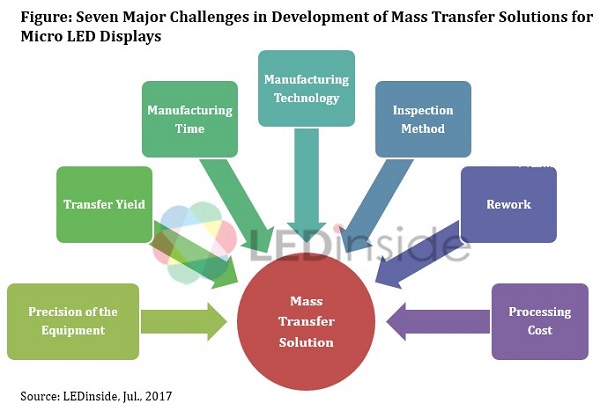A major bottleneck in the commercialization of Micro LED displays is the mass transfer of micron-size LEDs to a display backplane. Research by LEDinside, a division of TrendForce, reveals that many companies across industries worldwide have entered the Micro LED market and are in a race to develop methods for the mass transfer process. However, their solutions have yet to meet the standard for commercialization in terms of production output (in unit per hour, UPH), transfer yield and size of LED chips (i.e. Micro LED is technically defined as LEDs that are smaller than 100 microns). These research findings can be found in LEDinside’s 3Q17 Micro LED Next Generation Display Industry Member Report: Analyses on Mass Transfer and Inspection/Repair Technologies.
Currently, entrants in the Micro LED market are working towards the mass transfer of LEDs sized around 150 microns. LEDinside anticipates that displays and projection modules featuring 150-micron LEDs will be available on the market as early as 2018. When the mass transfer for LEDs of this size matures, market entrants will then invest in processes for making smaller products.
Development of mass transfer solutions faces seven major challenges
“Mass transfer is one of the four main stages in the manufacturing of Micro LED displays and has many highly difficult technological challenges,” said Simon Yang, assistant research manager of LEDinside. Yang pointed out that developing a cost-effective mass transfer solution depends on advances in seven key areas: precision of the equipment, transfer yield, manufacturing time, manufacturing technology, inspection method, rework and processing cost.
LED suppliers, semiconductor makers and companies across the display supply chain will have to work together to develop specification standards for materials, chips and fabrication equipment used in Micro LED production. Cross-industry collaboration is necessary since each industry has its own specification standards. Also, an extended period of R&D is needed to overcome the technological hurdles and integrate various fields of manufacturing.
Mass transfer has to achieve five-sigma level before mass production of Micro LED displays is feasible
Using Six Sigma as the model for determining the feasibility of mass production of Micro LED displays, LEDinside’s analysis indicates that the yield of the mass transfer process must reach the four-sigma level to make commercialization possible. However, the processing cost and the costs related to inspection and defect repair are still quite high even at the four-sigma level. To have commercially mature products with competitive processing cost available for market release, the mass transfer process has to reach the five-sigma level or above in transfer yield.
As progress on mass transfer solutions continues, true Micro LED products are expected to first enter applications such as indoor displays and wearables
Even though no major breakthroughs have been announced, many technology companies and research agencies worldwide continue to invest in the R&D of mass transfer process. Some of the well-known international enterprises and institutions working in this area are LuxVue, eLux, VueReal, X-Celeprint, CEA-Leti, SONY and OKI. Comparable Taiwan-based companies and organizations include PlayNitride, Industrial Technology Research Institute, Mikro Mesa and TSMC.
There are several types of mass transfer solutions under development. Choosing one of them will depend on various factors such as application markets, equipment capital, UPH and processing cost. Additionally, the expansion of manufacturing capacity and the raising of the yield rate are important to product development.
According to the latest developments, LEDinside believes that the markets for wearables (e.g. smartwatches and smart bracelets) and large indoor displays will first see Micro LED products (LEDs sized under 100 microns). Because mass transfer is technologically challenging, market entrants will initially use the existing wafer bonding equipment to build their solutions. Furthermore, each display application has its own pixel volume specifications, so market entrants will likely focus on products with low pixel volume requirements as to shorten the product development cycle.
Thin film transfer is another away of moving and arranging micron-size LEDs, and some market entrants are making a direct jump to developing solutions under this approach. However, perfecting thin film transfer will take longer time and more resources because equipment for this method will have to be designed, built and calibrated. Such an undertaking will also involve difficult manufacturing related issues.





 CN
TW
EN
CN
TW
EN






